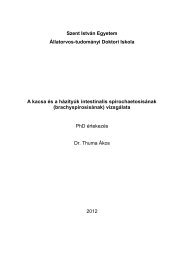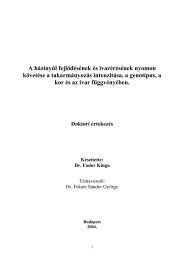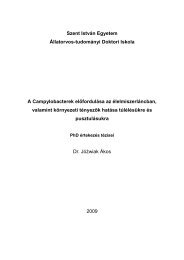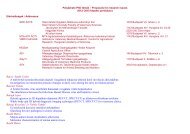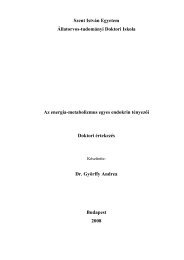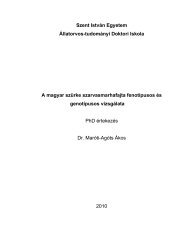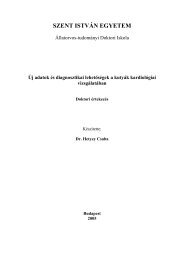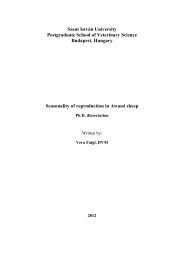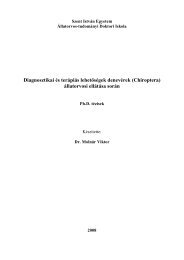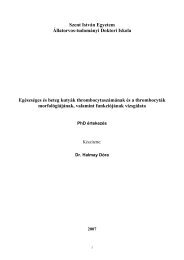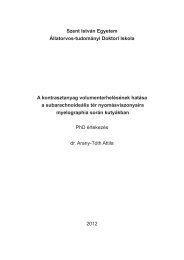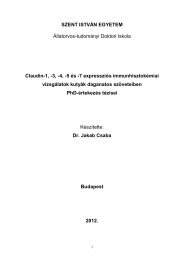PhD Thesis Demeter Zoltan
PhD Thesis Demeter Zoltan
PhD Thesis Demeter Zoltan
You also want an ePaper? Increase the reach of your titles
YUMPU automatically turns print PDFs into web optimized ePapers that Google loves.
Today a very diverse distribution of types 2a, 2b and 2c can be observed in most<br />
European countries (Decaro et al., 2007a), and there is evidence that the newest<br />
genotypes tend to replace previous variants (Martella et al., 2004; 2005; Decaro et al.,<br />
2007a). This replacement has been associated with increased ability to bind to canine<br />
transferrin receptors, although it might not rule out the possibility of mutations at<br />
residue 426 of the VP2 protein being selected also for their antigenic effects (Truyen,<br />
2006; Decaro et al., 2007a).<br />
CPV2 infections have been reported in several species, such as domestic dogs,<br />
bush dogs (Speothos venaticus), coyotes (Canis latrans), maned wolves (Chrysocyon<br />
brachyurus) and crab-eating foxes (Cerdocyon thous), but it can be assumed that most if<br />
not all Canidae are susceptible (McCaw & Hoskins, 2006). The original CPV2 isolates<br />
infected only dogs, whereas the newer genotypes (2a, 2b) can also infect cats<br />
experimentally and naturally as well (Parrish et al., 1988; McCaw & Hoskins, 2006).<br />
Not all infected animals develop clinical signs. Clinical illness however is most<br />
severe in young, rapidly growing puppies with concurrent parasitic infestation and/or<br />
bacterial, viral infections. In susceptible populations, the incidence of severe disease and<br />
death can be very high (McCaw & Hoskins, 2006).<br />
CPV2 is highly contagious and most infections occur as a result of contact with<br />
contaminated feces in the environment or fomites. Previous observations have<br />
demonstrated that the infectious virus survives for at least one year in sandy or clay<br />
soils (Greene & Schultz, 2006). The incubation period can vary among genotypes from<br />
7 to 14 days, but in field conditions in case of CPV2a and 2b it can be as brief as 4 to 6<br />
days. Acute CPV2 infections can be seen in dogs of any breed, age or sex. Nevertheless,<br />
pups between 6 weeks and 6 months of age, and some large breeds seem to have an<br />
increased risk (McCaw & Hoskins, 2006).<br />
3.3.2 Pathogenesis<br />
Similarly to FPV, the pathogenesis of CPV2 is defined by the requirement for mitotic<br />
cells, dividing lymphoid and intestinal epithelial cells being the primary targets of the<br />
virus (Parrish, 1995).<br />
The site of virus entry and initial natural infection occurs through the cells of the<br />
nasopharynx, the tonsils or other lymphoid tissues (Appel et al., 1979). Virus is isolated<br />
between 1 and 3 days after the infection from the tonsils, retropharyngeal lymph nodes,<br />
thymus and mesenteric lymph nodes, and after approximately 3 days virus is also<br />
30



